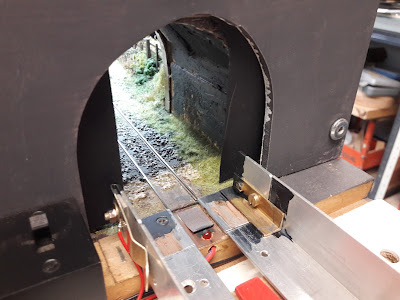Worklist:
Test 'cleaned' locomotives.
Fit new signal bell sound unit amplifier.
Titivate layout.
All three in attendance.
Geoff had been busy modifying some of John's stock. A coach with couplings independent of the bogies had them properly united. Putting such a 'vericle' (sic - John's pronunciation we often use, with affection) onto the track was nigh-on impossible, and we wanted to have it running. Geoff had also 'un-weathered' a pair of John's balcony brake vans. These had a very heavy pale grey dust coating, that when partially removed, looked much better. A couple of vans were also given the same treatment.
Geoff decided it was time to convert them to live frogs. He studied the matter carefully, then the 'Eureka' moment struck and a solution evolved. Firstly, the frogs would be converted into live frogs and isolated. Then, the four, independent point switches would be combined in a single three-way switch, reducing the routes and hence the frog-polarity options, to a minimum. After first resolving the problem with two relays linked to the points, another solution using a single relay on the mainline station point evolved. In conjunction with the three-way point switch, this would change frog polarities automatically, solving the problem. Laurence and Stephen were taken through the solution with the help of the diagram below. Whilst Stephen trusted the solution was viable, we were 4 weeks away from the Eastleigh show that meant no such work was going to take place in the short term. It was argued that we'd coped with the problem for years, and would, therefore, live with it until some time in the future when we had the time. Everyone was happy!!!
Stephen had rebuilt the water tower roof after the old one had started to distort and deteriorate. It just needs a coat of paint.
Stephen and Geoff spent the remaining time tidying and dirtying-up the platform area.

























